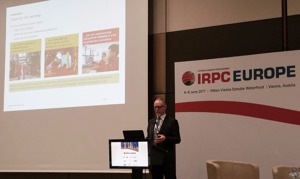IRPC Europe '17: Shell case study demonstrates VDU value maximization
VIENNA—On Day 2 of International Refining and Petrochemical Conference (IRPC) Europe, Jock Hughson, Licensing Technology Manager for Shell Global Solutions International BV, discussed how to maximize the value of a vacuum distillation unit (VDU) through a post-fractionation increase of vacuum gasoil (VGO) yield.
VDU revamps are often undertaken to increase VGO yields, to improve VGO quality and/or to improve the reliability of the furnace and washoil bed, Mr. Hughson said. VDU capacity may constrain the operation of the hydrocracker or the FCCU, negatively impact desired turnaround schedules, or result in suboptimal reliability in downstream conversion units.
Technology steps for boosting VGO yields. According to Mr. Hughson, Shell's deep-flash technology can help refiners increase their VGO yields without affecting the reliability of downstream units. The technology consists of five technology modules.
The first module, the furnace coil, helps improve reliability by reducing coking. The technology suppresses vaporization to control the furnace flow regime.
The second technology, Schoepentoeter Plus, improves VGO quality by using high de-entrainment efficiency at a lower pressure drop than conventional feed inlet devices. It also allows the processing of more difficult crude oils.
The third technology involves washoil section design. Coking is reduced, improving reliability. This results in longer cycle lengths and higher distillate yields. It also helps meet tighter product specifications.
Draw-off tray design, the fourth technology improvement, minimizes residence time in the tray with high velocity in the gutters. The design is insulated to minimize wild reflux, and has large open areas for a low pressure drop. This results in enhanced VGO yield and lower CAPEX.
The fifth technology module involves direct spray sections that achieve vapor condensation by direct contact with liquid in an empty space. This module also removes the need for packing and reduced column height, which reduces CAPEX. It maximizes distillate yield and recovery, since the lower pressure drop gives lower flash zone pressures.
Case study. A VDU revamp case study demonstrates how the deep-flash technology helped an Asia-Pacific refiner increase its hydrocracking capacity by boosting VGO production from the VDU.
The objectives of the revamp, as set forth by the client, included maximized recovery of VGO material, achievement of a VGO true boiling point (TBP) cutpoint of 575°C, minimized cracking and reduced CAPEX.
Several revamp options were considered; the client selected the option of installing a new furnace and column in series. No modifications to the existing VDU were required. The unit capacity was achieved without equipment constraints, and the overall VGO recovery from both units increased from approximately 54.5% to 77%.
According to Mr. Hughson, the critical success factors for the project included a clear understanding of the revamp objectives, an extensive scouting study that presented several options to the client, a tailored revamp solution, and continuous licensor support from the concept stage through commissioning.
IRPC Europe is taking place at the Hilton Vienna Danube Waterfront in Vienna, Austria, from June 6–8.







Comments